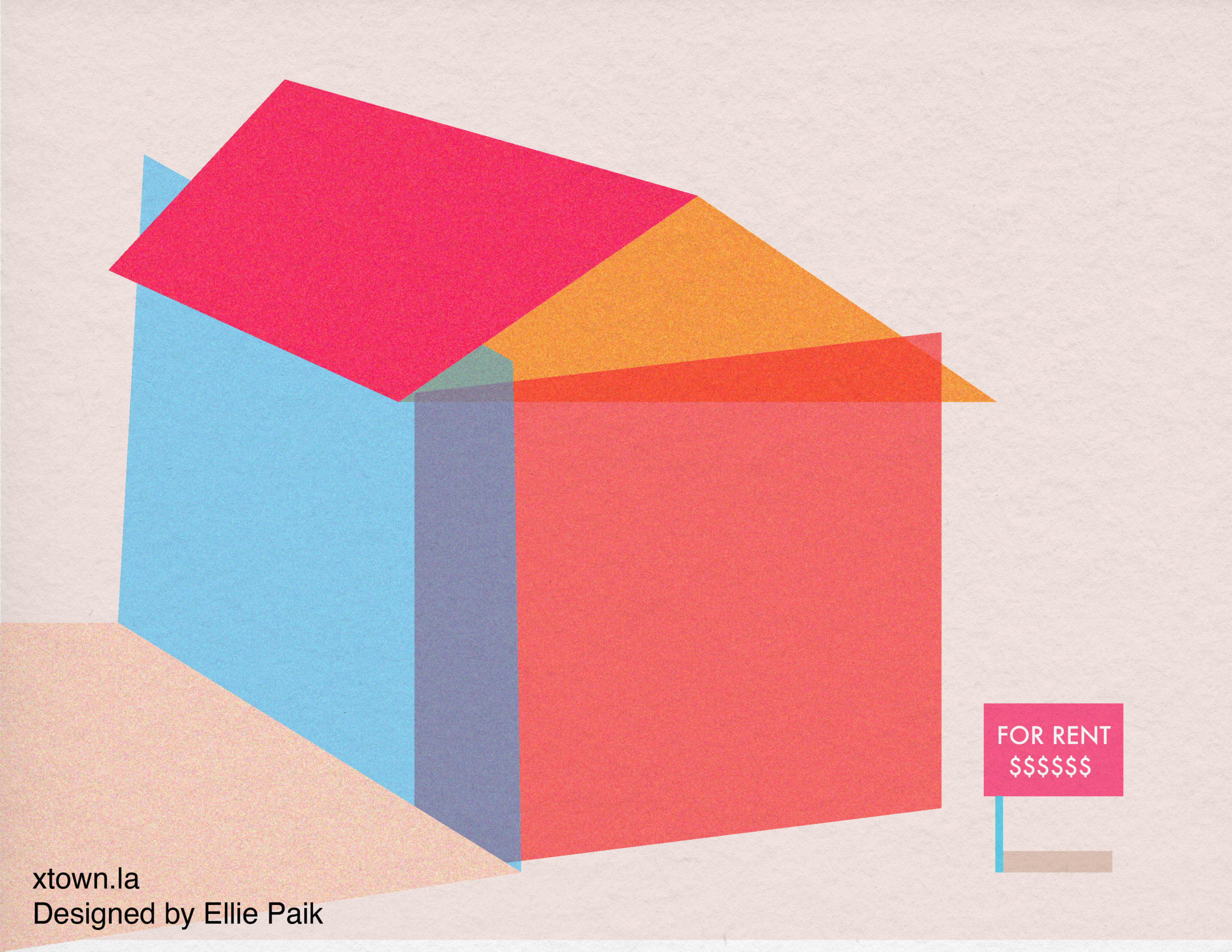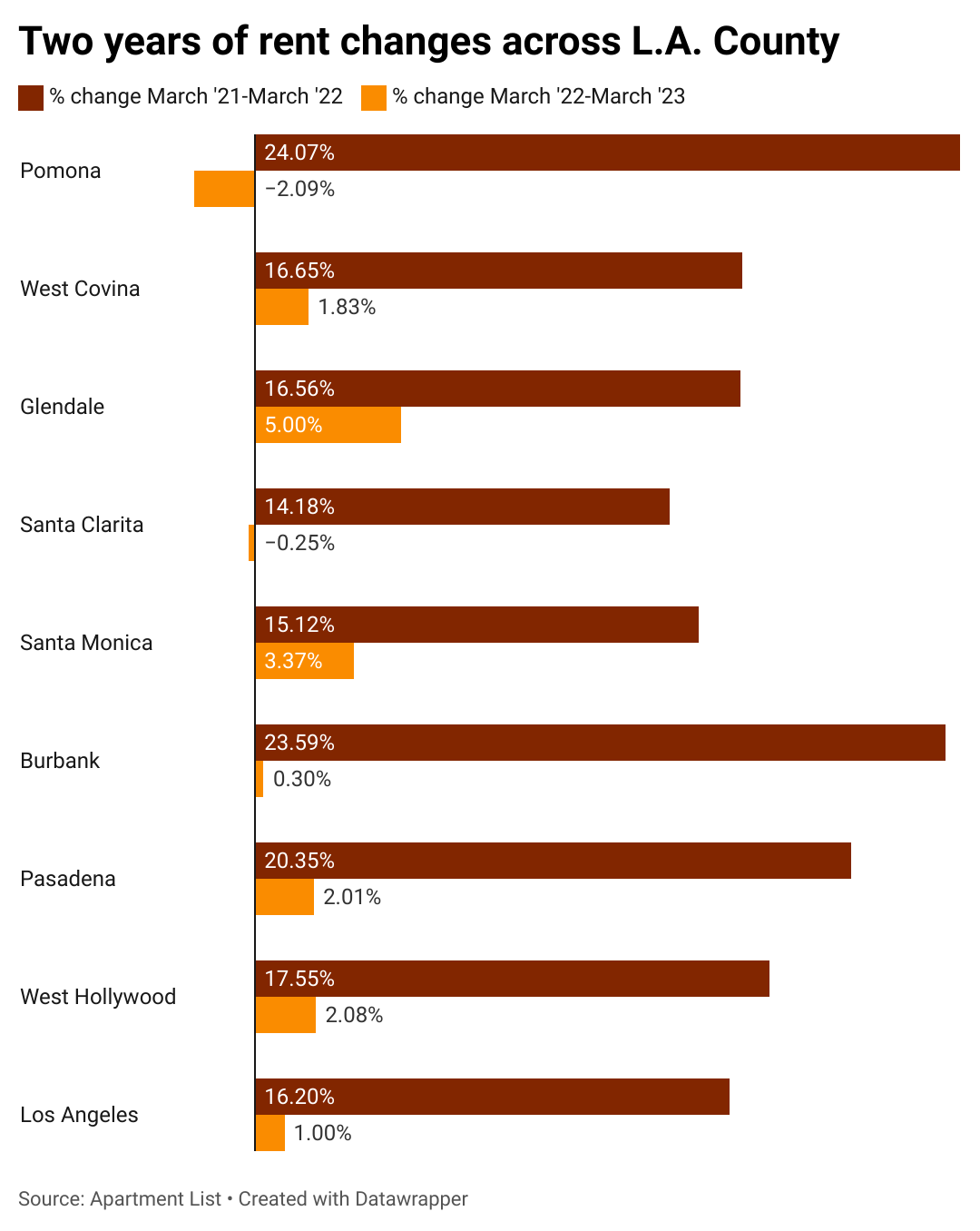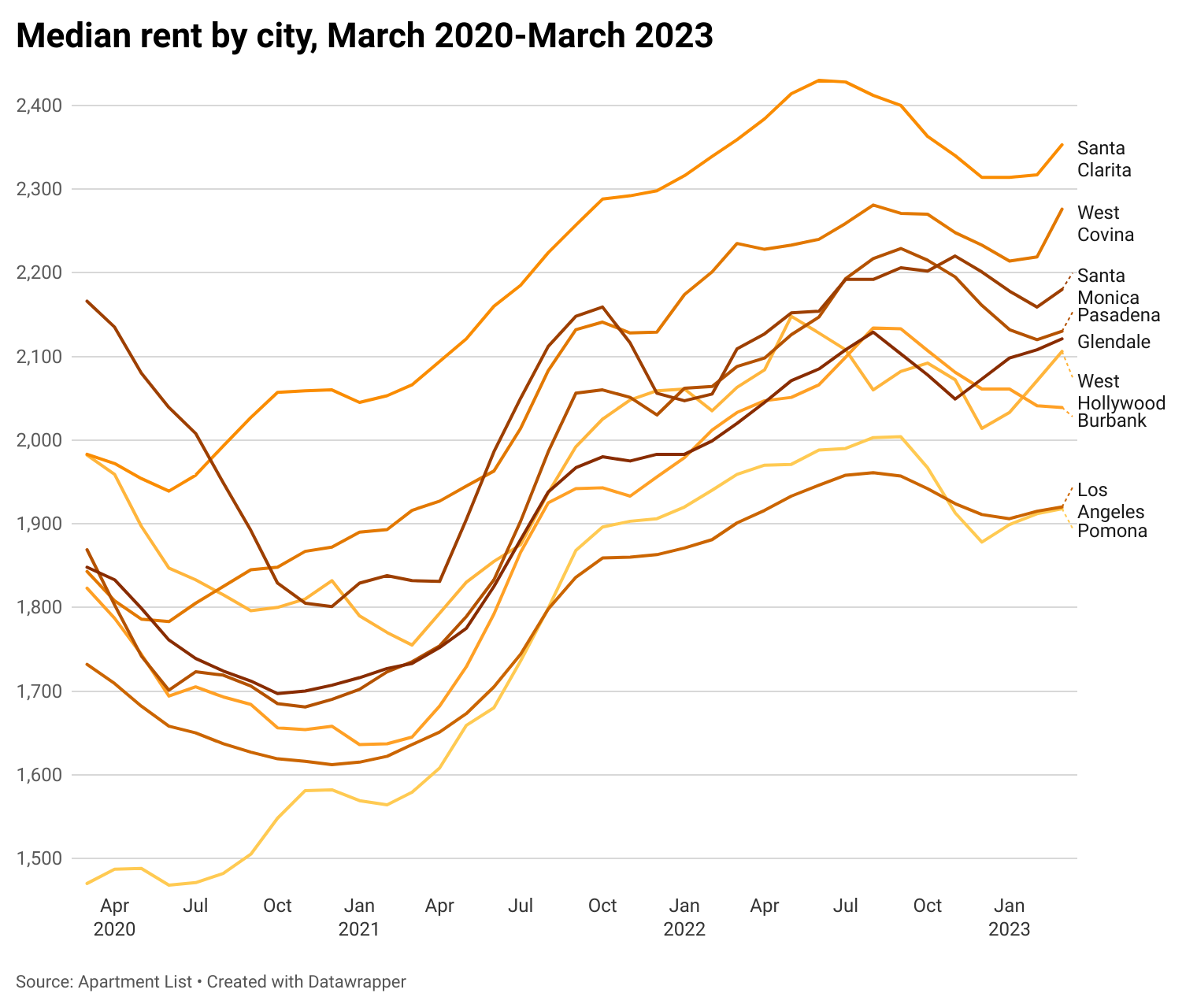L.A.’s rollercoaster rents show signs of easing

Los Angeles area rents, which had been on a tear during much of the pandemic, largely leveled off during the past year, relieving some of the sky-high housing costs that have burdened many Angelenos.
Over the past 12 months, the median rent for an apartment in Los Angeles County rose less than 1%, according to data compiled by Apartment List, an online rental marketplace. A year earlier, the increase had been more than 16%, driven by the region’s chronic housing shortage. Apartment List uses data from the U.S. Census Bureau as well as listings on its own platform to make its calculations.
Rents have been on a rollercoaster since the pandemic, which makes it hard to determine whether the current trend will continue. For renters who have been whipsawed by rising housing prices, this past year was a welcome respite. The Los Angeles metropolitan area is the fourth-most rent-burdened metro area in the country, according to Moody’s Analytics. A University of Southern California study determined that 73% of Angelenos spend over 30% of their income on rent and utilities.
Notably, some cities which had seen the steepest increases during the pandemic, such as Pomona, where rents rose more than 24% a year ago, have now experienced the sharpest declines.

Lydia Fisseha, a student who lives in the South Central neighborhood of Los Angeles, took advantage of the rent drop when she signed a new lease this year. She began searching for apartments with the goal of finding a larger space. Fisseha, a student, had been paying $744 a month for a shared room in a four-person apartment. But that lease was running out and the rate was set to rise.
After searching, she secured a new lease for a one-bedroom apartment at $1,200. Her new rent is roughly the same price she would have paid for a shared room had she remained at her previous apartment.
[Get housing, crime and other stats about where you live with the Crosstown Neighborhood Newsletter]
“I wouldn’t have saved any money if I had stayed,” said Fisseha. “I was surprised. It was hard to find, and people were actually shocked that I found a single at this price.”
Rent whiplash
When the pandemic first hit, temporarily grinding the economy to a halt, rents in the Los Angeles area initially took a dip. Then, as the lockdown dragged on and people were stuck inside, many renters fled dense urban areas for suburban communities that offered more space. That caused rents to spike in places such as Santa Clarita, West Covina and Pasadena.
After a record median low of $1,722 in December 2020, rents sharply increased in Los Angeles County as residents moved into surrounding cities that are historically more affordable, such as Pomona.

That has led to a seismic shift in the way people live and work in the region, according to William Yu, an economist with the UCLA Anderson Forecast. “Now companies do not need as much space as before. They only need a half to a third of the space,” he said. “We are seeing the office rent decline as well, and [residential renters] prefer larger and cheaper spaces in suburban areas.”
Of the nine major Los Angeles cities surveyed by Apartment List, the ones with the cheapest median rents as of March were Pomona ($1,918), Burbank ($2,039) and Los Angeles ($2,085).
Growing supply
Despite Los Angeles’s battle with overcrowding and a housing crisis, Yu says the demand for apartments is stabilizing while supply increases. The flattening rent prices come in the midst of an elevated number of permits issued by the city Department of Building and Safety. Last year, there were 4,685 permits for new construction, the highest number on record.
“With these high interest rates and this kind of weak housing market, it’s good for more renters to be able to afford to rent a place,” said Yu. “But from the point of view of investors, developers, or real estate owners, it’s not so good.”
As of March, residential vacancies have increased by 20% in the Los Angeles metropolitan area since last year’s apex in August, according to Apartment List. However, Yu notes that the vacancy rate is far greater for offices due to a rise in work-from-home policies.
Still, it’s a positive sign for California’s statewide housing crisis, where an increase in the cost of living has historically outpaced states such as Arizona and Texas, according to Yu.
Affordable housing has been at the forefront of Los Angeles’s legislative bulletin for years. In 2020, the state passed AB 1482, which caps rent increases for residential properties throughout the state at a rate of 10% every year. The rent cap is another check that has prevented landlords from greatly boosting their unit prices post-pandemic.
Los Angeles County lost 90,704 people from July 2021 to July 2022, according to a recent U.S. Census report, more than any other county in the country. This exodus of California residents could be another contributor to the flattening rent prices.
“We see a convergence. California’s cost of living is rising at a slower speed now,” said Yu. “States that were [historically] cheaper… you see their home prices rising rapidly compared to California’s.”
‘When you raise the rent, people move’
While the tamed market signals hope for Angelenos looking to rent, it takes a toll on landlords’ profit margins. Marcy Vasquez, who manages a residential property in Burbank, described her efforts to maintain rent price stability while dealing with inflation and the aftermath of the COVID-19 pandemic.
“When you raise the rent, people move,” Vasquez said. “We’ve had to work extra jobs because our mortgage and our property taxes have gone up. Our water bills, electrical bills, gardener costs, everything has gone up.”
Los Angeles’s county-specific eviction moratorium, which began in March 2020, ended April 1. With the removal of these renter protections, landlords are again able to evict tenants who have missed payments, given that they provide a 30-day notice.
Instead of risking vacancies by evicting tenants or raising the rent, Vasquez has decided to offer monthly repayment plans. With many tenants still struggling to catch up with payments postponed during the pandemic, the high school teacher is operating her property at a greater expense.
“We go back with our tenants a long time. They’re more like family to us,” said Vasquez. “And right now, we know it’s especially hard for them.”
How we did it: We compiled monthly average rent data provided by Apartment List from across Los Angeles County.
Have questions about our data? Write to us at askus@xtown.la.






